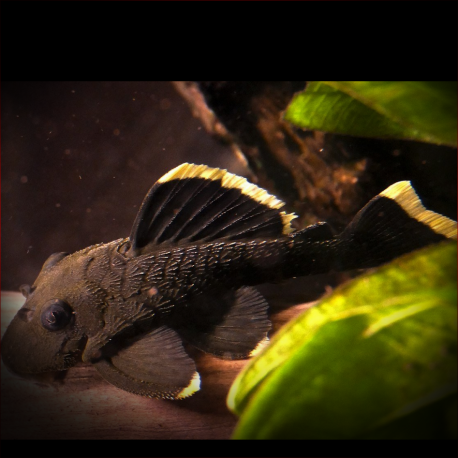More info
Datasheet
| Minimum Tank Size | 240 litres / 63.40 US gallons |
| Maximum Size | 21.9cm / 8.62inches |
| Temperature | 27°C / 80.60°F - 32°C / 89.60°F |
| Hardness | 2.02dgH / 36ppm - 12.05dgH / 215ppm |
| pH | 6.0-7.5 |
General Description
The Baryancistrus chrysolomus, commonly known as the Mango Pleco or L047, is distinguishable by a light-colored band on its dorsal and caudal fins, with adult specimens exhibiting a slightly reduced band. Belonging to the Loricariidae family, it possesses a unique enlarged membrane posterior to the last branched dorsal-fin ray, setting it apart from other catfish species. With a maximum size of 21.9cm, it is a species that requires specific tank conditions and care, and it sports a complex taxonomy within the catfish family.
Aquarium Setup
To maintain Baryancistrus chrysolomus successfully, a tank set-up resembling a flowing river is recommended. A substrate of rocks, gravel, and large boulders can be adorned with driftwood, roots, and robust aquatic plants like Microsorum and Anubias species. Adequate lighting is crucial for promoting aufwuchs growth, as these fish prefer grazing on such natural food sources. Maintaining pristine water conditions with ample dissolved oxygen and water movement is essential, typically achieved through canister filters and powerheads. Weekly water changes of 40-70% are highly recommended to ensure a healthy environment for the fish.
Behaviour
Juvenile Mango Plecos are generally peaceful, but as they mature, particularly males become highly aggressive towards both conspecifics and any perceived territorial threats. They are best kept with medium-to-large sized characids or other fish that occupy different tank regions. In large aquaria, they may coexist with other catfish species if adequate territorial space and visual barriers are provided in the tank layout.
Feeding and Diet
In the wild, Mango Plecos primarily feed on algae, especially diatoms and filamentous genera like Spirogyra, along with small invertebrates such as chironomids and bryozoans. In captivity, their diet should consist of high-quality sinking dried foods with added vegetable content, live or frozen bloodworms, fresh fruits, vegetables, and occasional defrosted prawns or shrimp. Home-made gelatine-bound recipes containing a mix of puréed fish food, shellfish, fruits, and vegetables are also beneficial. Given their high metabolic rate, they may require multiple daily meals initially.
Reproduction & Dimorphism
Reproduction details of the Mango Pleco are currently unreported. Sexual dimorphism is challenging to ascertain, with mature females being slightly rounder in the forehead and belly compared to males.
Habitat and Distribution
Endemic to the Rio Xingu basin in Pará state, Brazil, the Baryancistrus chrysolomus inhabits sections of the river's main channel above Belo Monte falls. They are often found in whitewater rapids but tend to prefer calmer habitats, sheltering under rocks in marginal zones with slow to moderately flowing water. In their habitat, they coexist with various fish species like Peckoltia vittata and Hypostomus sp.

